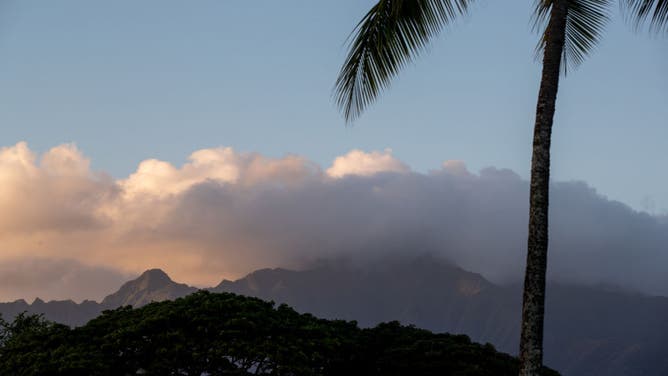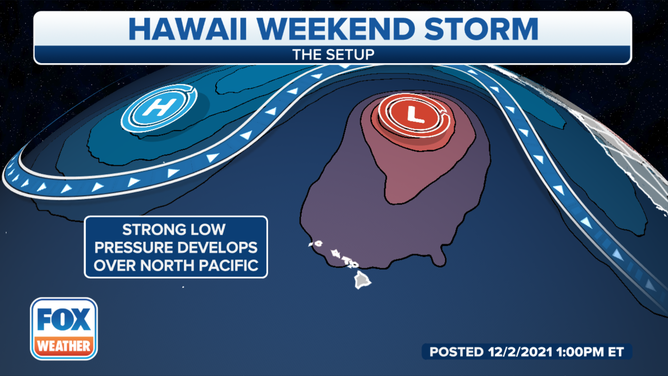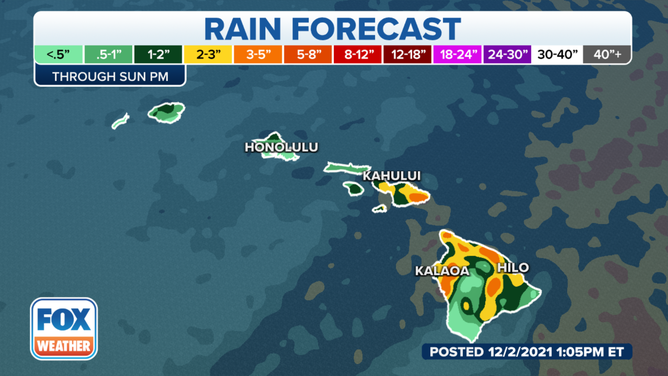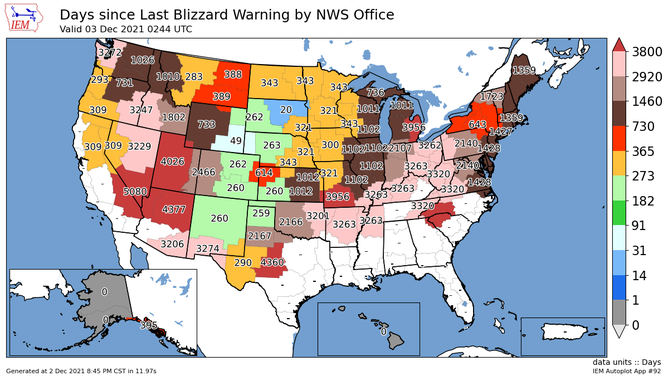'Kona low' brewing heavy rains for Hawaii, prompts blizzard warning for mountains
The storm is also expected to bring heavy snows and 100 mph wind gusts to the summits of the mountains on the Big Island.

Conditions prior to the commencment of the Round of 64 at the Michelob ULTRA Pure Gold, WSL Haleiwa Challenger on November 29, 2021 at Haleiwa, O'ahu Hawai'i.
(Tony Heff/World Surf League / Getty Images)
HONOLULU -- A storm percolating in waters near Hawaii is set to not only bring heavy rain and possible flash flooding to the islands this weekend but heavy snows and 100 mph winds to the higher volcanic peaks on the Big Island, prompting a rare Blizzard Warning for the tropical state.
What is a Kona Low?
Hawaiian weather often brings to mind visions of abundant sunshine, but Kona Low storm systems frequently bring tremendous amounts of precipitation to the islands.
The storm, known locally as a "Kona Low," could bring torrential rain into the islands as soon as late Friday and Saturday and lasting into early next week. The rain's "duration and intensity is likely to produce numerous flooding impacts," according to National Weather Service forecasters in Honolulu.

(FOX Weather)
A Flood Watch is now in effect for all of the Hawaiian Islands through Monday afternoon.
The Big Island and Maui have the most significant risk for flooding with several inches of rain possible, but heavy rains have the potential to cause flooding problems in Oahu and Kauai as well.

(FOX Weather)
"Roads in several areas may be closed, along with property damage in urban or low lying spots due to runoff," the National Weather Service office in Honolulu wrote in its Flood Watch. "Isolated highways, such as the Belt Highway in the Big Island's Kau District, and Piilani Highway on Maui, may be closed in one or more locations, resulting in long detours or even the isolation of communities. Landslides may also occur in areas with steep terrain."
On the Big Island, up atop Mauna Loa and Mauna Kea above 8,000 feet, Blizzard Warnings -- yes, you read that right -- and High Wind Warnings are in effect from Friday evening through Sunday night. The storm is expected to bring heavy snows to the mountain summits from Friday night and Saturday night, with total accumulations up to 12 inches or more.

(FOX Weather)
In addition, numerous wind gusts of 50-80 mph are likely with localized gusts over 100 mph, causing periods of zero visibility.

Numbers of days since a Blizzard Warning has been issued in the region. Hawaii now stands at 0 days.
(IEM / Iowa State University)
The Dry Side Becomes the Wet Side
The term "Kona" comes from the Hawaiian word for "leeward," according to NASA.
Typically the persistent trade winds in Hawaii blow from the northeast. But these storms bring a southwestern wind, reversing the flow and bringing heavy rains to the usually drier, rain-shadowed areas of the leeward side of the various mountains.

(Frazier, A. G., Giambelluca, T. W., Diaz, H. F. and Needham, H. L. (2016), Comparison of geostatistical approaches to spatially interpolate month-year rainfall for the Hawaiian Islands. Int. J. Climatol., 36(3), 1459-1470. doi: 10.1002/joc.4437)
These storms are most common in October to April in Hawaii and get their power from cold centers instead of the warm centers that power hurricanes and tropical storms. Yet the storms still tap into abundant warm, tropical moisture that slams into the dramatic topography of the islands to squeeze out several inches of rainfall.
The storms have also been capable of high winds, hail, and thunderstorms, in addition to the winter fury atop the volcanoes.
